"Cinnamon Breads, Fresh from your Oven"October 21, 2010 - Volume 1, Issue 16
|
|
|
|
|
|
Baking Season
| What's better than sliced bread? Fresh bread straight from your own
oven! With cooler weather upon us, it's baking season. Specific flavors
come forward and mark these autumn moments - cinnamon, nutmeg, allspice,
ginger, and clove. Our breads, (and apples, pumpkins, and squash)
hunger for the company of these spices, and our kitchens gladly oblige.
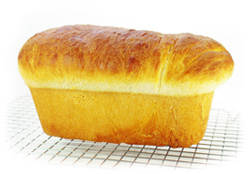 IN THIS ISSUE, we celebrate autumn with a "how-to" on making bread. We delve a bit
into the world of cinnamon deepening our appreciation for this
ubiquitous spice, and finish with a small primer on a key baker's tool,
the stand up mixer. We offer tips and answer questions on all of the
above, and finish with three premier bread recipes. The aromas of
cinnamon bread flowing from the oven are unrivaled - try it, you'll like
it! IN THIS ISSUE, we celebrate autumn with a "how-to" on making bread. We delve a bit
into the world of cinnamon deepening our appreciation for this
ubiquitous spice, and finish with a small primer on a key baker's tool,
the stand up mixer. We offer tips and answer questions on all of the
above, and finish with three premier bread recipes. The aromas of
cinnamon bread flowing from the oven are unrivaled - try it, you'll like
it!
|
Ken's Notes:
|  Mark your calendars - Sunday, November 14 is our first Open House and you're invited! Mark your calendars - Sunday, November 14 is our first Open House and you're invited!
Open House
Sunday, November 14
Throughout the afternoon we'll be giving away fabulous gifts, dropping prices on summer items and running promotions on our favorite kitchen tools. But most of all, we invite you to stop in, relax, have a little food and raise a glass of cheer with us as we celebrate our first year on Front Street!
Need a little more incentive? How about two parties? Our good neighbor Jon Givens, at Simple Pleasures, will be holding his open house at the same time! So grab a friend or two, put on your dancing shoes (now I'm getting carried away) and join the party!
Extended Fall Hours: Starting November 1st we'll be open on Mondays through the end of December.
|
|
|
|
Cooking Classes at The Cook's Shop!
| 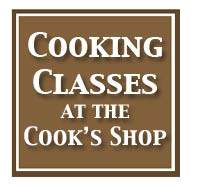
We've had to cancel our October 24th Chantal class. The instructor has been trying to shake off a cold for a few weeks and rather than take a chance, she opted to be safe and stay home. We'll reschedule sometime early next year.
Hearty Winter Soups - Monday, Nov 1, 2010 - 6:30 pm, $30
Gayle Shank - In-house Chef. With cold weather comes comfort foods... and wonderful soups. Learn how to make Six Onion Soup, Hungarian Mushroom Soup, Butternut Squash Soup and possibly one more. Class is limited to 15.
Coffee, Bean to Brew! - Saturday, Nov 6, 2010 - Two Sessions, 9:30 or 11:15 am, $15
Lorraine Walker - Owner, Roaster, Silver Bridge Coffee, Gallipolis, OH. French roast, fair trade, coarse grind.... Do you really know what these terms mean when it comes to your coffee? Lorraine will discuss where coffee is grown and how altitude and conditions change the flavor of the beans. You'll learn about roasting techniques and actually see a batch of beans roasted. Discover which beans are bold or mild and how each should be ground for optimum flavor. Plan on drinking lots of different coffees. Each participant will take home a complementary Silver Bridge travel mug! Class is limited to 15.
Eggs... Morning, Noon And Night - Monday, Nov 8, 2010 - 6:30 pm, $30
Gayle Shank - In-house Chef. Learn to make a delicious Quiche, fantastic Frittata, great German Apple Pancakes and more. Class is limited to 15.
Gingerbread Wonderland, Hands-on Class For Parent & Child - Monday, Nov 15, 2010 - 6:30 pm, $45. David McIntyre - Baker, The Little Stir Bakery, Vienna WV. You and your child (10 and over) will learn how to make and roll perfect gingerbread. Each student will receive prepared pieces for a gingerbread house along with building and decorating techniques and designs. We'll supply the decorations, but you're free to bring your own if you want to add something special. Best of all, you'll take home a completed Gingerbread House! Parents are expected to be in attendance and help their children. Class is limited to 12.
Chocolate Indulgences - Monday, Nov 22, 2010 - 6:30 pm, $40
Gayle Shank - In-house Chef. Just in time for the Holidays - Chocolate Tortes! You'll learn to make Sour Cherry Chocolate Torte, Rum Chocolate Torte and... Class is limited to 15.
Christmas Goodies - Monday, Dec 6, 2010 - 6:30 pm, $35
Gayle Shank - In House Chef. Come watch, learn, and nibble on wonderful confections that are perfect for gift-giving! You'll learn how to make specialty cookies, Fudge, Truffles and Biscotti. Class is limited to 15.
Entertaining Right - Make Ahead Appetizers - Saturday, Dec 11, 2010 - 6:30 pm, $40
John Murphy, culinary arts teacher, Barry Tech, Nassau County, NY. During the holidays do you find yourself spending too much time in the kitchen while you miss the party? There's no excuse now - John will teach you how to make delicious and beautiful appetizers that can all be prepared in advance and brought out at just the right moment, quickly and easily! Class is limited to 15.
Breads In Under An Hour - Monday, Dec 13, 2010 - 6:30 pm, $30
Gayle Shank - In House Chef. Back by popular demand! English Muffin Loaf, Cuisinart French Baguette and Italian Bread, Dinner Rolls, and of course, something to spread on your bread - Boursin Cheese. Class is limited to 15.
|
How to Make Bread
|
The alchemy of baking bread is easy and within everyone's reach! The key to bread making is in paying attention to temperatures along the way, and in massaging the dough to build the bread's character. Yeast multiplies and thrives at warmer room temperatures. Kneading the dough allows the grain's glutens to form and become elastic. Follow these steps to make the perfect loaf of raisin cinnamon bread. (Recipe below). 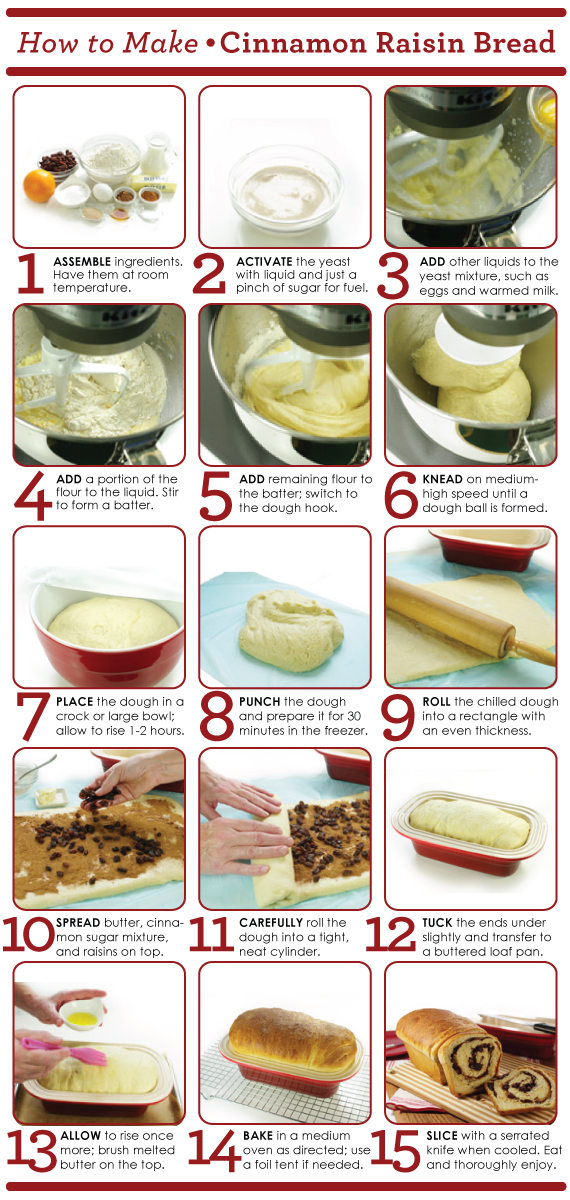 |
Cinnamon Spice and All Things Nice
| Cinnamon ranks in spice popularity right behind salt and pepper. It flavors breads, pastries, pies, and all sorts of baked goods, but also provides key character to curries, tagines, stews, casseroles, and so much more.
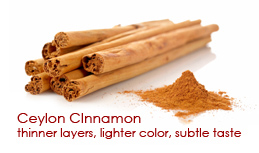 Cinnamon is the inner bark of the cinnamon tree. Branches are cut from the tree, the outer bark pounded away revealing the inner bark that peels away and curls up. The bark peel is dried and cut into small lengths. Cinnamon is the inner bark of the cinnamon tree. Branches are cut from the tree, the outer bark pounded away revealing the inner bark that peels away and curls up. The bark peel is dried and cut into small lengths.
We find cinnamon in powdered form, and in a stick form, also known as a cinnamon quill. Sticks of cinnamon keep their flavor longer, while ground cinnamon has more potency. Store cinnamon tightly sealed in a dry, cool, and dark place. Cinnamon will keep its flavor about six months in powdered form, and about one year in stick form.
Variations of cinnamon come from different species of the cinnamon tree, genus Cinnamonum, and differ based on where the tree is grown. While there are hundreds of variants, here are some more culinary cinnamons:
- Ceylon Cinnamon - This cinnamon is considered the norm, or "true cinnamon" with subtle characteristics that are considered most desirable and refined. It is said to have a spicy, citrus quality. Ceylon cinnamon quills have paper-thin layers and are easily ground.
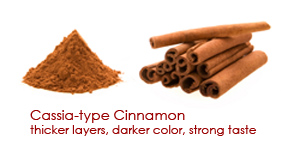 Cassia Cinnamon - This Chinese variety is more common and less expensive than Ceylon cinnamon. It is said to have a harsher flavor than the complex Ceylon cinnamon. Cassia Cinnamon - This Chinese variety is more common and less expensive than Ceylon cinnamon. It is said to have a harsher flavor than the complex Ceylon cinnamon.- Korintje Cinnamon - An Indonesia cassia variety, this cinnamon has the least potency and is the least expensive. Because of its availability, it is most frequently used in baked goods even though it is considered a lesser product.
- Saigon Cinnamon - Grown in Vietnam, this cinnamon, also a cassia variant, has a bold, pungent flavor, and is available as powder or bark chips.
- Madagascar Cinnamon - Marketed as an elite cinnamon, Madagascar cinnamon is the closest to Ceylon Cinnamon. It has a lighter color and a subtly sweet taste. It also shares the paper-thin bark layers of "true cinnamon."
|
Stand Up Power
| Many cooks comment, "I can't believe I waited this long to get a stand mixer!" The might and versatility that a good stand mixer provides can revolutionize your cooking routines. A stand mixer provides heavy-duty power for the more strenuous tasks in the kitchen. If you're a baker, mixing heavy doughs such as cookie doughs or bread doughs, can be difficult by hand and beyond the ability of a hand mixer. A quality stand mixer provides the necessary power to make mixing easy for the baker, and the best part, mixing is a hands-free operation.
Considerations for Choosing a Stand Mixer - When considering a stand mixer, consider the following characteristics:
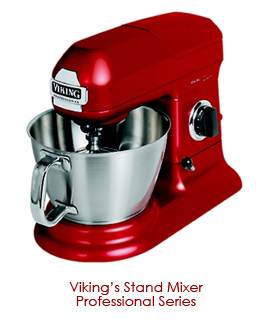 Size Matters - Determine how you plan to use the mixer and match the size of the bowl and the motor to your needs. Some mixers quantify in easy terms how many loaves of bread it can make, how many dozen cookies, or pounds of mashed potatoes. These real-world measurements help guide your choice. Size Matters - Determine how you plan to use the mixer and match the size of the bowl and the motor to your needs. Some mixers quantify in easy terms how many loaves of bread it can make, how many dozen cookies, or pounds of mashed potatoes. These real-world measurements help guide your choice.- Ease of Operation - Assess the ease of operating the stand mixer. Are the On-Off and speed controls easy to operate? Is it easy to place and remove the bowl? Are the attachments easy to get on and off the drive shaft?
- The Bowl - In addition to size considerations check that the bowl fits snuggly in its place. A secure bowl that will withstand powerful mixing without slipping or wobbling is important. Practice placing and removing the bowl to judge the ease of working with the locking mechanisms.
- The Attachments - Most stand mixers come with three standard attachments: a paddle for mixing and stirring, a whisk for whipping tasks, and a dough hook for mixing bread. Additionally, most upper-end mixers will also include a shield that reduces splattering from the bowl, or loose flour from flying around.
- The Color - Gone are the days of white-only mixers. Mixers come in all kinds of colors and finishes. Not only is the stand mixer a valuable tool, it looks good in your kitchen while working or idling.
More Than a Mixer - Lending heavy-duty power to kitchen mixing tasks is reason enough to invest in a stand mixer. However, the unit possesses additional "motor skills." Specific attachments are available according to your cooking interests: pasta rolling, grinding meats and foods, sausage stuffing, juicing and straining, shredding, slicing, and even ice cream making.
|
Smart Bread Making Tips
| Tip #1: For breads that have fillings, like the raisin swirl bread or the sticky buns below, chill the dough overnight, or freeze for 30 minutes. The cold will stiffen the dough, make it less sticky, and increase your ability to roll it out to the desired size.
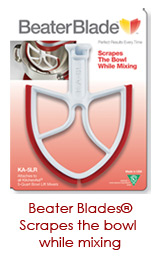 Tip #2: Beater Blades® are an aftermarket product that incorporate a sturdy rubber edge to the paddle attachment. The result is a mixing process that does not require frequent stopping to scrape down the sides of the mixing bowl. Beater Blades® are configured for all major brands and specific models of stand mixers. Tip #2: Beater Blades® are an aftermarket product that incorporate a sturdy rubber edge to the paddle attachment. The result is a mixing process that does not require frequent stopping to scrape down the sides of the mixing bowl. Beater Blades® are configured for all major brands and specific models of stand mixers.
Tip #3: When mixing bread doughs in a stand mixer, allow time for the flour to be absorbed and activated by the liquids. Sometimes doughs benefit from standing a few minutes before the kneading step. An important chemical reaction is taking place that cannot be hurried with faster mixing. The moistened flour changes again during kneading. Knead the bread for the full time required.
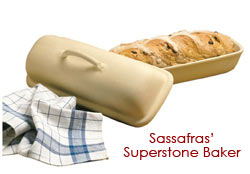 Tip #4: Bake breads in heavier metal bakeware that transfers heat evenly and simultaneously insulates the outer crust. Alternatively, bake (and serve) in stoneware that also evenly heats and protects the baking bread. Tip #4: Bake breads in heavier metal bakeware that transfers heat evenly and simultaneously insulates the outer crust. Alternatively, bake (and serve) in stoneware that also evenly heats and protects the baking bread.
Tip #5: Check your bread after about 20 minutes of baking. If it is browning too quickly, tent the pan with aluminum foil set loosely on top.
Tip #6: Dissolve yeast in warm water or liquid that's between 105-115°F. Use an instant read thermometer to check the temperature, or check with a drop to the inside of your wrist; it should feel warm, not hot. Add ingredients to the yeast mixture that are at room temperature; cold eggs, for example, will shock the yeast at this early, tender stage and stunt its growth.
|
Q & A's
| 
Q: What is the difference between "active dry yeast" and "instant dry yeast?" Does it matter?
A: Active dry yeast is a more traditional dry yeast form and requires a dissolving or proofing step prior to adding the flour. 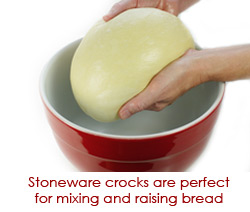 Instant Yeast (aka "Fast-Rising®," "Rapid Rise®," "Quick Rise®" "Bread Machine") has a smaller granule size and, therefore, absorbs liquids much faster. It is generally not necessary to dissolve or proof instant yeast. Most often, when using active yeast, two rises of the bread are used, where with instant yeast, a short resting period followed by the final rise is common. Four parts active yeast equates to three parts instant yeast if substituting one for the other. Instant Yeast (aka "Fast-Rising®," "Rapid Rise®," "Quick Rise®" "Bread Machine") has a smaller granule size and, therefore, absorbs liquids much faster. It is generally not necessary to dissolve or proof instant yeast. Most often, when using active yeast, two rises of the bread are used, where with instant yeast, a short resting period followed by the final rise is common. Four parts active yeast equates to three parts instant yeast if substituting one for the other.
Q: Why did grandma use an old crock as her
bread-making bowl?
A: Grandma knew the secret of temperature when making bread. The magic of bread making happens when the yeast grows and the glutens form and stretch. Both taste and structure develop in the process. Yeast grows at just the right bread making speed in warm room temperatures. Stoneware provides an insulating capability that moderates the temperature of rising bread from drafts and ambient temperature changes.
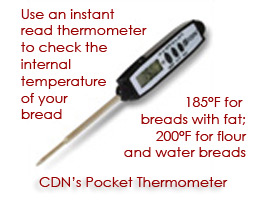
Q: How can I tell if my bread is done?
A: There are several ways to assess doneness. First of all, follow a reliable recipe and its instructions for pan size, oven temperature, and timing. Check the color of the baking bread. Invert a loaf and tap on the bottom; it should sound hollow. Or, use an instant read thermometer. Breads with primarily flour and water will be done when the internal temperature registers around 200°F. Breads containing eggs or fat will be done at around 185°F internally.
Q: What are the no-knead bread making methods that one hears so much about today?
A: Today's no-knead bread methods are actually a throwback to older bread making techniques where time compensates for kneading through "micro-kneading" action of the yeast.
|
Cookbook Review
|
|
Baking, from My Home to Yours by Dorie Greenspan published by Houghton Mifflin, New York, NY. Copyright 2006. All rights reserved.
#1 in the 2010 Baker's Dozen List of "Essential Baking Cookbooks of All Time"
by the James Beard Foundation Book Awards Committee
2007 Winner of the James Beard Foundation's Cookbook Award
Baking and Desserts Category
| 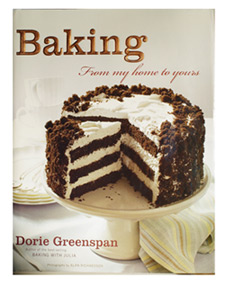 |
This hefty book is worth its weight in gold! We're long time fans of Dorie Greenspan and her earlier tome, Baking with Julia. In Baking, From My Home to Yours, we're treated to expert guidance in all manner of baking ranging from breakfast sweets, cookies, cakes, pies, tarts, "spoon desserts," and, of course, breads. It's much more than a collection of recipes that define the number of cups or teaspoons of this or that. She lets you in on the artful side of baking. Her imaginative writing paints a picture for such esoteric concepts as a "shaggy dough," or a "silken batter." It's like having an expert over your shoulder navigating baking nuances with you, teaching you texture, look, and the changing character of your evolving creation. Her style of presentation entertains as well as informs. The photographs by Alan Richardson replete with many vintage-inspired scenes, completes the aptly crafted recipe/stories. These recipes fall into the "trusted" category, the type that always work, gain raves all-around, and become "true keepers." This is a book that we always reach for when its time to turn on the oven and bake!
|
|
Three Fresh Bread Recipes
|
|
Raisin Swirl Bread
View & Print
When comfort food comes in a loaf, it's as cinnamon raisin bread. This recipe produced a generous, delicious loaf with plenty of raisins, just the right amount of cinnamon all captured in a swirl of bread. The bread dough assembled easily and was a delight to handle. As hard as it is to wait, it will slice best when cooled.
| 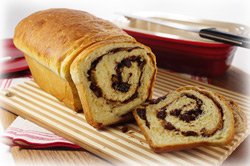 | |
Golden Brioche Loaves
View & Print
A brioche is a bread boosted with plenty of eggs and butter. The result is a very rich bread with plenty of taste. A stand mixer facilitates the formation of the dough that requires a fair amount of mixing. The flavors develop further through an overnight refrigeration step. It's easier than it appears, and totally worth it when you take the first bite of a toasted slice.
| 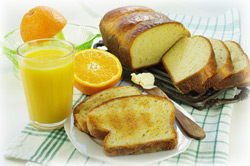 | |
Pecan Sticky Buns
View & Print
Based on the brioche dough above, these pecan rolls rate top on our list, and we consider ourselves sticky bun experts! The chilled brioche dough rolls out well, and curls well around a filling of butter, cinnamon, brown sugar, and white sugar. The dough pinwheels are placed on top of a layer of caramel and pecans. Life is sweet with these buns on your plate!
| 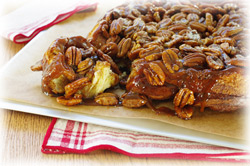 | |
Recipes from Baking, from My Home to Yours by Dorie Greenspan through permission of Houghton Mifflin, New York, NY. Copyright 2006. All rights reserved.
|
|
|
| James Beard said, "Good bread is the most fundamentally satisfying of all foods; and good bread with fresh butter, the greatest of feasts." We heartily agree! |
|
|
|
|